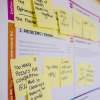Leonardo da Vinci once said, “Simplicity is the utmost sophistication.”
For anyone who has designed products, you would know how difficult simple is. Luckily, there are hundreds of problem-solving methods available today that you can choose from. One such is the “How Might We” (HMW) technique, a faithful arsenal in the design thinking principles and a stalwart in the design sprint process.
It’s a simple exercise, but one that can stretch your imagination. It’s fun and made for group exploration.
What is the HMW technique?
The HMW exercise is one of the early steps to designing a solution. You need a problem statement or a problem with defined parameters such as user, context, and environment. You will be asking a series of HMW questions to shed more light on the problem.
The keyword here is ‘might’. Naturally, when we are faced with a problem, we will ask “How can we solve this?” or “How should we overcome this?” The word ‘can’ imply that we are able to solve it and ‘should’ implies that we must solve it.
Changing it to ‘might’ imply that a solution is a possibility, but we don’t know yet whether we can or should solve it. The HMW exercise is about exploring ideas freely, so that we have a variety of ways to approach the problem, not to produce a solution.
How Might We Questions
Your problem definition shouldn’t be too grand because you might end up solving nothing. You also shouldn’t define a super specific challenge to the point that there is only one obvious solution for it.
Look at this example of a challenge that is too wide, too specific, and just right.
- Too broad: Help people fight global warming. (We all know this is a complex problem.)
- Too narrow: Help people track, reduce, and share their carbon footprint automatically using a smartwatch. (We are limiting the function and form of the solution.)
- Just right: Help people track their personal carbon footprint.
Using the challenge above, we can create many HMW questions. You can extrapolate it, inject emotions to it, or break the challenge down into different areas. There’s a useful guide from the Hasso Plattner Institute of Design at Stanford University, on how to craft meaningful HMW questions.
”Point of view/problem: Help people track their personal carbon footprint
1. Showcase the good
- How might we reward people who track and reduce their carbon footprint?
- How might we influence other people to lower their carbon footprint?
2. Inject emotions
- How might we make people feel guilty that they are increasing their footprint?
- How might we make people feel excited to keep lowering their carbon footprint?
3. Try the opposite
- How might we guess the impact of a person’s personal carbon footprint?
- How might we track the total community’s carbon footprint?
- How might we track a person’s personal carbon offset?
4. Take it to the extreme
- How might we do a live emission tracking of everyone’s carbon footprint?
- How might we get someone to reverse or offset their carbon emission?
5. Question the assumption
- How might we prove lowering personal emissions does slow down global warming?
6. Use adjectives
- How might we make tracking personal carbon footprint the coolest trend that even teenagers and kids would love it?
7. Divide into different areas
- How might we link a person’s carbon footprint to grocery and utility bills?
- How might we automatically track a person’s carbon footprint from their vehicle?
How to do a HMW exercise?
I usually allow an hour to do a HMW activity, and it’s done on the first day of a design sprint. Prior to starting, make sure you brief everyone on how it works.
If you’re running a face-to-face activity, then you need a large empty wall or whiteboard, loads of sticky notes of the same size, markers, and dot stickers. If this is a remote design sprint or HMW activity, you can use an online whiteboard app like Mural or Miro and invite everyone to collaborate.

1. Write down the problem
Establish the challenge, the current reality, the context, the user, and the parameters based on data and insight you have gathered. Make sure everyone thoroughly understands the issue in hand.
2. Get everyone to think and write HMW questions individually
If you have defined the problem carefully, it is easy to come up with HMW questions. You will write one HMW question on a sticky note and stick it up on a wall. Or create different sections for each participant to create their HMW questions in an online whiteboard app.
Use the technique above to attack the problem from different angles. A HMW question may have different answers to it, and that’s good because you’re expanding the possibilities of your solution.
3. Group the HMW questions
The host or facilitator will now group similar HMW questions, that’s addressing a particular area. You’ll start to see a pattern as you are grouping them.
4. Cast your votes
Everyone gets to vote on the HMW question they feel is most important, for each section. This will give you a priority list of possible solutions, and the general direction of what the solution will look like. Ideally, the HMW should align with your business goals.
The HMW technique is a wonderful ideation tool that reframes a problem into positive challenges that you want to tackle. It forces you to see things in different context, thereby getting your creative juices flowing freely towards a solution. After a HMW exercise, you will have a clearer idea of what the answer looks like, for you to eventually design the solution.







